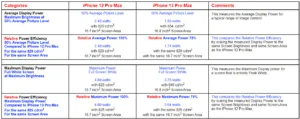After a moment of pleasure at seeing the latest review of display of the iPhone 13 Pro Max by Display Daily friend and occasional contributor, Dr. Ray Soneira, I had a moment of pause as it highlighted the recent loss of one of our writers, Steve Sechrist, who was the usual commentator on Ray’s work over the years (Sad News – Steve Sechrist).
Ray starts out the review by pointing out how far OLED displays for smartphones have come in the 11 years that he has been evaluating them, from last place in the earliest review to top place of some years now. Highlights for the display are:
- Higher refresh rate at 120Hz compared to 60Hz for the iPhone 12 Pro Max
- 27% higher maximum brightness than last year’s handset
- HDR Peak brightness is 1200 cd/m²
- Better colour accuracy (although for some years this has basically been an academic issue)
- 25% better power efficiency
- Smaller camera notch (just 1.3% of the display area)
Overall, the display gets the highest overall rating and gets ‘very good to excellent’ awards for every parameter. It has very accurate standard (sRGB/Rec. 709) and WCG (DCI-P3) coverage at 104% and 102% respectively.
Ray looks particularly at performance in high ambient conditions and one of the factors that influences this is the reflectance from the surface of the display and that got worse between the iPhone 11 and 12, drifting from 4.5% to 4.8%, but this year the trend was towards improvement at 4.6%.
The other factor in high ambient is brightness and brightness is high so the contrast is very good with a ratio of 231:1 even in high ambient lighting. That’s very, very good. The display is also particularly good at maintaining its colour accuracy when the average picture level changes from small peaks of just 1% APL to bright images at 50% APL (typical TV and movie content is in the range of 10% to 30% APL – Editor).
So, in terms of static image quality, the new display moves things along significantly, especially in terms of the power consumption which has a direct impact on battery life, especially as the adoption of 5G increases the power consumption of smartphones. Unless you beef up the battery or accept a shorter battery life, you have to make efficiencies and the achievement of 25% better power consumption is a big deal. The review points out that most of the improvement in power consumption is a result of the lower refresh rate when tests present static images which went down to 10Hz.
One of the factors that will have helped the power consumption is the use by Apple for the first time of LTPO technology (for an explanation of this widely discussed, but not well explained, technology here LTPO is a Hot Technology – but What Is It?). The LTPO also enables the variable refresh rate.
In theory, Apple now allows apps to update from 10Hz (which minimises power consumption) to 120Hz (which optimises image clarity in fast moving scrolling or in apps). However, 9to5Mac reported that there seems to be a bug in the feature, which Apple calls “ProMotion”. Perhaps, more accurately, I should say that there is a bug in the OS support. The bug stops apps using the high update rate except in scrolling or performing full screen transitions. The article quotes Apple as promising that full support is ‘coming soon’.
Given Ray’s comments over the years on the human factors aspects of pixel density and contrast on visibility, we were surprised not to see comment from him on the high refresh rate feature, so we reached out to him. However, we had not heard back from him at press time.
However, there are those that have been looking at the performance and Macworld thought that ‘reading articles and browsing timelines already feels great’. Even allowing for the fact that Macworld might tend to favour Apple, the article said that ‘it’s definitely noticeable to go back to a non-ProMotion display, especially when it happens within the same app’.
Of course, Apple is not the first to introduce 120Hz based on LTPO. It has already appeared on the OnePlus 9 Pro (which Ray has already reported on) and the Galaxy S21 Ultra.
You can find Ray’s full review of the iPhone 13 Pro Max here. (BR)
After publication, I got this back from Ray.
The PWM Frequency is typically 4 times the Refresh Rate, but the iPhone 13 maintains the same high PWM Frequency for all Refresh Rates from 120 Hz to 10 Hz, and then chooses the most efficient combination of PWM and Analog Brightness Control for the given Refresh Rate and image content”.

